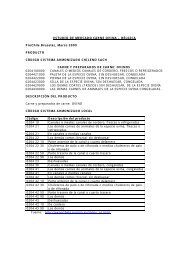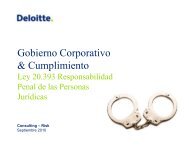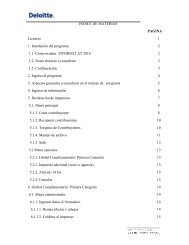10 Things
10 Things
10 Things
You also want an ePaper? Increase the reach of your titles
YUMPU automatically turns print PDFs into web optimized ePapers that Google loves.
<strong>10</strong> <strong>Things</strong><br />
ABOUT TOUGH TIMES<br />
Barry SalzBerg
<strong>10</strong> <strong>Things</strong><br />
ABOUT TOUGH TIMES<br />
Barry SalzBerg<br />
C H I e F e X e C U T I V e O F F I C e r<br />
D e l O I T T e l l P
As I completed my first year as CEO, the U.S. and global economies<br />
had entered a downturn the likes of which I’ve not seen in my 31 years<br />
here. Even more jarring is the fact that this now-official recession<br />
began in a year that certainly ranked among our best ever. Suddenly,<br />
we have had to switch gears from good times to tough times.<br />
So what are some secrets to good leadership in a situation like this?<br />
In this <strong>10</strong> <strong>Things</strong> I have distilled what I think are some useful lessons<br />
learned from a host of downturns: the early ’90s, the dot-com bust, and<br />
the aftermath of 9/11, among others. These are lessons that apply both<br />
to our dealings with our clients and our people.<br />
Many younger colleagues and new partners at Deloitte * have never<br />
experienced a downturn and have never had to take the actions that<br />
times like these require. And some long-timers may need some<br />
refresher tips.<br />
One important point: In a downturn, the pressure to stretch boundaries<br />
always increases. When we look back on today from the better times<br />
down the road, we will want to remember that we never for a moment<br />
compromised our standards of quality and integrity, no matter what<br />
the pressures might have been to do so.<br />
Hopefully, this booklet will serve as a reminder to “old hands,” as well<br />
as a primer for a new generation as we make our way through this<br />
recession and prepare for the upturn and the prosperous years that<br />
most certainly lie ahead.<br />
*As used in this document, “Deloitte” means Deloitte LLP and its subsidiaries.
- 1 -<br />
S w i t c h Ge a r S<br />
It’s difficult to move suddenly from good times to bad. Many younger<br />
leaders have never been through anything like this, while some older<br />
leaders may be out of practice or reluctant to come to grips with the<br />
reality of hard times. In any event, we as an organization are faced with<br />
a multitude of difficult facts of life. And that calls for the decisiveness<br />
of “downturn leadership” – that is, leadership that is quick to grasp a<br />
situation, and equally quick to take appropriate action.<br />
What are the characteristics of downturn leadership, and what is the<br />
magnitude of the challenges leaders face? For one thing, in a downturn,<br />
the stakes are higher. The toll on everyone is greater, the conversations<br />
more charged, and the decisions more daunting. In short, the altered<br />
landscape requires leaders to tap into different and perhaps long-unused<br />
skill sets rising to a new level of intensity, both in helping others stay<br />
focused on the tasks at hand and in making the critical decisions required.<br />
As we deal with a downturn, here are some of the things we need to<br />
ask ourselves: Just what actions are and will be warranted by the scale<br />
and scope of the situation? What is similar and what is different this<br />
time around? What can be gleaned from past lessons? What absolutely<br />
needs to be done right now? What can wait?<br />
Downturn leaders need to take on more; we must stay close to our<br />
people on the front lines and engage with our clients more actively.<br />
Napoleon once observed, “Adversity is the midwife of genius.” We<br />
must be ever vigilant to recognize and seize any opportunities that<br />
might be masked by difficult times.
- 2 -<br />
F i n d a wa y t o wi n<br />
Going into Super Bowl III in 1969 the New York Jets were 18-point<br />
underdogs. But Jets quarterback Joe Namath hadn’t quite gotten that<br />
message. “We’re gonna win this game,” he said. “I guarantee it.” And<br />
Namath and his team delivered on that promise, beating the Baltimore<br />
Colts 16-7. In many ways it was because the Jets simply refused to lose.<br />
That same refuse-to-lose attitude needs to drive our business – doubly<br />
so in tough times. When capital markets tighten and tensions increase,<br />
clients become skittish and objectives more elusive. It is then that leaders<br />
need to become more immersed than ever in the details of the business,<br />
working more closely with clients, being alert for hidden opportunities –<br />
taking every advantage of ways to win in the marketplace. And leaders<br />
must strongly drive expectations at every level, providing a clear<br />
understanding of what success looks like.<br />
Of course, refuse-to-lose is also about staying in the game: no retreat – no<br />
surrender. Consider the three Apollo 13 astronauts when an oxygen tank<br />
exploded thousands of miles from earth. The odds were heavily stacked<br />
against them. And yet, Gene Kranz, lead flight director for Mission<br />
Control, told his somber ground team, “Failure is not an option.”<br />
And so for four days, almost without sleep, the engineers on earth and<br />
astronauts in space never stopped improvising. Finally, the three men<br />
splashed down safely. Why? Because the entire team found a way to win<br />
by never giving up. That’s the kind of tenacity tough times require.
- 3 -<br />
B e th e r e F o r cl i e n t S<br />
Take a moment and try to imagine the downturn from a client’s<br />
perspective. Their customers are hesitant to buy. Their stock is taking<br />
a beating. The future is uncertain. Pressures are mounting all around.<br />
Suddenly, survival mode strategies become common conversation.<br />
Now imagine the peace of mind that we bring to the struggle – being<br />
there as a trusted ally, ready to climb right down into the trenches.<br />
However, to enable that kind of close collaboration, we need to have<br />
not only a constructive outlook but also a keen understanding of just<br />
what our clients are facing.<br />
At the same time, we need to realize the importance of never<br />
compromising our standards in the work we do for clients. After<br />
all, reputations (and companies) are built not only on seeing the job<br />
through to a successful completion, but they are also built on quality<br />
and integrity – forged by objectivity and uncompromising values.<br />
In much the same way that a cornerman coaches a fighter in the ring,<br />
we offer clients the acuity of our trusted inside/outside perspective –<br />
a panoramic view of the competitive arena from a vantage point<br />
of relative calm. We must capitalize on that objectivity and, when<br />
appropriate, bring in experts from other disciplines so clients can see,<br />
in practice, the power and value of our multidisciplinary model.<br />
When all is said and done, being there for clients means focusing<br />
on them not as nameless, faceless organizations, but as individuals to<br />
whose success we are vitally committed, both in good times and in bad.
- 4 -<br />
P r o j e c t co n F i d e n c e<br />
a n d re a c h ou t<br />
As I’ve said more than once, when I’m on an airplane and we hit<br />
turbulence, I look at the flight attendants to see how they are reacting.<br />
If they seem calm, which is most of the time, I remain calm. But<br />
if they start scurrying, I start worrying. The same goes for how our<br />
people observe us as leaders, especially when storm clouds appear.<br />
Project confidence. Pay attention to what you’re communicating.<br />
Realize the power of humor to hearten and lighten the mood.<br />
Convey the fact that “this too shall pass.”<br />
First and foremost, use your emotional intelligence, especially when others<br />
may be withdrawing or even shutting down. Reach out. Make the time.<br />
During a downturn, when people are especially vulnerable, it is more<br />
important than ever that we all stay connected with one another.<br />
I don’t claim this is easy, especially when so many other urgent matters<br />
are competing for our attention. Yet the ability to keep going and to<br />
keep others moving forward is one of the hallmarks of a downturn leader.<br />
Because in tough times, we can be sure people are watching and taking<br />
their cues from us. In fact, they are watching our every move.
- 5 -<br />
t e l l it St r a i G h t<br />
In a downturn, truth can be the first victim, followed closely by trust.<br />
But if there’s one thing that can help turn the tide, it’s the power of<br />
straight talk to our people.<br />
Look at the dynamics. Emotions running high. Message boards on<br />
overdrive. Rumors rampant. With little good news and the possibility<br />
of cuts on the horizon, it can be all too easy for leaders to wall<br />
themselves off – to be “too busy.”<br />
To combat this temptation, we need to communicate more often and to<br />
deliver the news straight, unvarnished, and, whenever possible, face to<br />
face. Never underestimate the power of your physical presence.<br />
This is precisely what I’ve been doing in my Straight Talk “town hall”<br />
series, and I’ve been doing it with a spirit of candor that I believe can<br />
be duplicated at all levels. Maintain an open door policy. Institute<br />
“office hours.” Or simply ask some of your people out for coffee. Be<br />
creative. But find a way.<br />
True, people may not always like what they are hearing, but deep down<br />
they will appreciate the candor and respect you are showing. Why?<br />
Because, in a world filled with spin and hype, they’ll see that you’ve<br />
taken the time and made the effort to give it to them straight.
- 6 -<br />
c o S t cu t t i n G al o n e<br />
w o n ’ t cu t it<br />
As those of us who have lived through a downturn or two know,<br />
we can’t simply cut our way out. Ultimately, we’ve got to grow our<br />
way out. In fact, cost containment and growth should be seen as<br />
complementary actions – especially during times like these.<br />
To be sure, cost cutting is an important aspect of a downturn strategy<br />
and a strong signal to our people, demonstrating that the organization<br />
has a full grasp of the situation and is dealing with it. But if our<br />
actions end there, we are sending the wrong message: namely, that we<br />
are an organization merely trying to hold old turf, not one ready to<br />
break new ground.<br />
That is why growth is so critical – especially during uneasy times, when<br />
people are constantly worried. Energizing and future-focused, growth<br />
plans speak volumes about how we intend to prevail. Instead of perceiving<br />
just a hold-and-protect message, people see an organization bent on<br />
only one direction – up. What’s more, once this message gets across,<br />
people can better visualize their own roles in blazing that upward path.<br />
Thus, when we think of containing costs, we simultaneously need to<br />
think about growth and all that comes with it. It’s by striking the<br />
right balance between the two that we will shake off the doldrums,<br />
motivate our people, and win the future.
- 7 -<br />
o u t -na v i G a t e ,<br />
o u t m a n e u v e r , ou t -th i n k<br />
“They’re not biting.” “The water’s too rough.” “The weather’s not<br />
letting up.”<br />
People have long been drawn to the sea, and while many have set sail<br />
even in the stormiest weather, others have found a host of excuses to<br />
remain docked or hug the shore. A similar situation can be found in<br />
economic environments such as the one we face today; some make bold<br />
moves, while others find reasons to simply stay put.<br />
Time and again it’s been shown that those who venture forth with a<br />
vision and seek out new worlds of opportunity reap rewards for themselves<br />
and others far beyond those who will not sail outside the harbor.<br />
So, we must make sure we have the right bearings, refocus our sights<br />
if necessary, change course when appropriate, and find ways to navigate<br />
the current situation toward new possibilities. A confident plan of<br />
action will demonstrate to clients and potential clients that we have<br />
the qualities they look for most in a professional services organization –<br />
especially in hard times.<br />
Faced with new realities and uncharted waters as we are today, we must<br />
not hang back. We must steer doggedly forward, focusing on innovation,<br />
quality, service, and, of course, profitability. Above all, we must be<br />
resolute in our determination to reach our objectives and emerge stronger.
- 8 -<br />
m a k e ev e r y da y co u n t<br />
After a downturn, some organizations will come out on top, and we<br />
need to make sure that we are among them. One important thing we<br />
can do toward that end is ensure that everyone is decisively engaged at<br />
all times – that no one is left on the sidelines.<br />
In other words, everyone must play a full-time part. Cut costs where it<br />
makes sense, improve processes, find ways to generate revenue growth,<br />
and raise the bar on teaming. At the same time, focus nonstop on flawless<br />
execution. As far as I’m concerned, there are no better times than<br />
tough times for reevaluating and retuning our organizational engines.<br />
The fact is, in a downturn our people will want to feel more counted<br />
on, just as they will want to work even harder. Give them that<br />
opportunity. Ask them how they can uniquely contribute, then let<br />
them feel the power of their own involvement.<br />
Giving people a renewed sense of purpose and direction improves<br />
morale. It enables people to reprioritize and seek out new opportunities.<br />
In turn, it helps them better understand what they can expect from<br />
the organization. The result: the kind of top-to-bottom accountability<br />
that truly makes each person, and each day, count.
- 9 -<br />
r e F r e S h<br />
Unless we’re careful our work-life balance and health can be casualties<br />
of a downturn. Do not let that happen.<br />
Healthy people make for a healthy business – and more satisfied<br />
clients. Healthy people are also a key hallmark of our brand and what<br />
clients can expect from us. So, take some time to de-stress. Spend more<br />
quality time with your family. See your friends and reconnect with<br />
your closest friend – you. In short, see to it that you carve out the time<br />
to recharge and replenish.<br />
Keep in mind the fact that, amid the insecurities of hard times, people<br />
may resist taking paid time off – at their peril and the organization’s as<br />
well. Leaders need to make sure this doesn’t happen. If we’re to attract<br />
the best people and the best clients, we all need to be at the top of our<br />
game – fresh, not frazzled.<br />
The same holds true when it comes to nurturing our remarkable<br />
partnership. Think about it. When times are tough, what client would<br />
want to hire yet more tension, stress, and negativity? I have a one-word<br />
solution: refresh.
- <strong>10</strong> -<br />
P u t Fi r S t th i n G S Fi r S t<br />
If there is one thing I have learned in my more than three decades<br />
here it’s that loyalty and commitment to the organization are the<br />
underpinnings of Deloitte’s success, and ultimately of our success as<br />
individuals. This is something we can’t lose sight of, even in tough<br />
times. Thus I urge you always to put the organization first.<br />
This is not only a sign of true maturity but also the “true north”<br />
of leadership. It’s also a mark of the caring, engaged leadership that<br />
people ultimately remember and respond to.<br />
Consider the example of Lieutenant General Hal Moore. In 1965, as a<br />
lieutenant colonel, he personally led 450 men of the 7th Cavalry in<br />
arguably the fiercest battle of the Vietnam War. What was one of the<br />
secrets of his brigade’s esprit de corps? Hal Moore promised his soldiers<br />
that he’d be on the first chopper in and that he’d stay with them until<br />
the last chopper was out. And, with that pledge, his forces prevailed<br />
against staggering odds.<br />
Think of the power of Moore’s promise. It was his commitment to his<br />
troops that made the difference in the outcome of the battle. He put<br />
his military unit above himself. In like manner, when we put the interests<br />
of Deloitte first – perhaps more than ever in difficult times – we ensure<br />
the ongoing strength and vitality of this organization.
-notes-
Copyright ©2009 Deloitte Development LLC. All rights reserved.

















